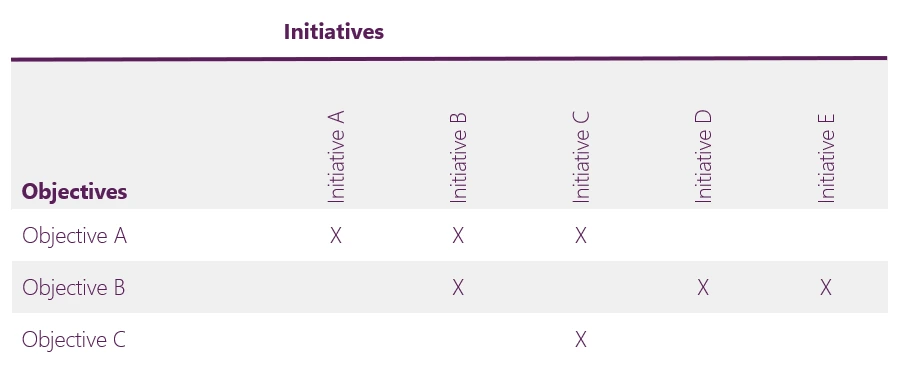A Goal/Objective Matrix provides insight into the relationships and interdependencies between goals and objectives. An Objective/Initiative Matrix provides a similar picture. Specifically, it visualizes the relationship between objectives and initiatives.
Initiatives
Initiatives are necessary to translate strategic goals into actionable projects and activities. Particularly, they drive change and resource allocation, helping architects implement architectural changes that support the organization’s strategic direction. Initiatives are used to effectively plan, manage and execute the projects and activities that lead to the successful realization of the organization’s strategy.
In short, an initiative is a concept used to represent a planned action or project designed to achieve specific goals or objectives within the organization. Initiatives are concrete activities that are undertaken to implement changes, improve processes, or achieve desired outcomes as part of the overall strategy of the organization. As a result, they are directly linked to specific goals or objectives of the organization. Initiatives represent the actionable steps taken (projects, programs, or activities that implement architectural changes) to achieve these goals and ensure that the Enterprise Architecture is aligned with the strategic direction of the business. By defining specific initiatives, the Enterprise Architect can determine the necessary resources, such as funding, people, and technology, to execute the projects and achieve the desired results.
In similar fashion to a business process, an initiative specifies the (high-level) activity or activities that must be performed to achieve an end result. Work packages work accordingly.
Each initiative should define the actions to be taken1.
Gathering information
To develop a list of initiatives, senior management can be asked the following questions:
- What projects or programs are underway?
- What specific sets of activities are part of these projects or programs?
- How will the completion of these activities contribute to the achievement of the objectives?
- Which business actor (business unit or department) performs these activities?
- Who is responsible for the execution of the initiatives?
- Can the initiatives be planned in a roadmap?
Creating the matrix
In an Objective/Initiative Matrix, the intended objectives are related to the initiatives. Hence, it shows the relationship between two elements. As can be seen by creating this cross-mapping, it becomes clear which initiatives contribute to the achievement of which objectives.
- Record all the objectives and initiatives deduced from the organization’s strategy.
- Compare the initiatives and make sure they are all sufficiently different from one another.
- Link the initiatives to the various objectives.
- Take extra care to link the initiatives to all possible objectives they have a relation with.

By mapping initiatives to objectives, it becomes clear which initiatives may overlap with multiple objectives. Hence, it is advisable to approach initiatives on a project basis. The project manager can be instructed to include the requirements of each objective in the project plan so that the initiatives to be implemented contribute to the achievement of all the objectives, not just one.
Initiatives may overlap with multiple objectives. It is therefore conceivable that the implementation of a particular initiative contributes (in part) to the achievement of one or more objectives. The degree of contribution may vary from objective to objective.
More information
For additional information about creating an Objective/Initiative Matrix, please refer to Chapter 8, Section 8.3.3.4, of my book Getting Started with Enterprise Architecture.
Back to
- W. Kuehn, Strategy to Reality. New York: Morgan James Publishing, 2023. ↩︎
